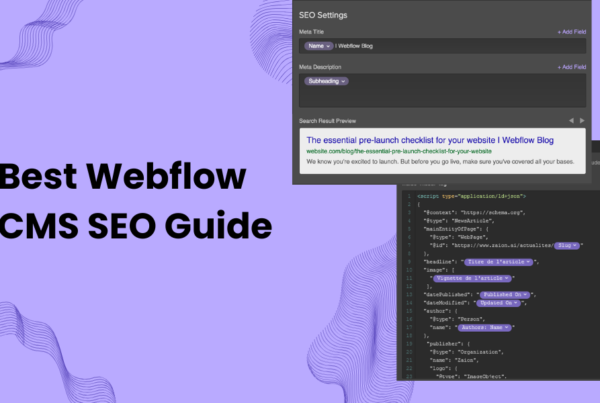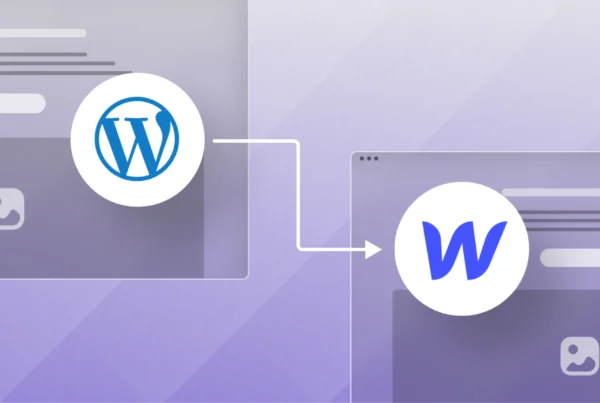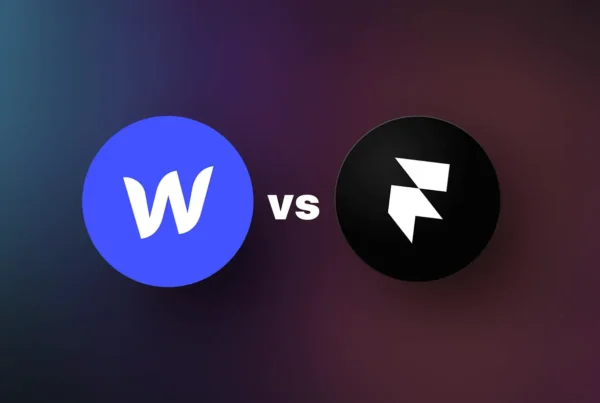
Webflow vs WordPress: Which Platform Should You Choose in 2025?
Choosing the right platform to build and manage a website can feel overwhelming. With so many options available, Webflow and WordPress often rise to the top of the discussion. While WordPress has been the go-to solution for nearly two decades, Webflow has gained massive popularity in recent years for its modern, design-focused approach.
If you’re wondering which one is right for your website in 2025, you’re in the right place. In this post, we’ll do a deep comparison of Webflow vs WordPress—covering ease of use, design flexibility, pricing, SEO, scalability, and more—so you can make an informed decision.
Quick Snapshot: Webflow vs WordPress
- WordPress: Powers over 40% of the web, loved for its flexibility, massive plugin ecosystem, and open-source nature. Great for blogs, business sites, and complex projects.
- Webflow: A rising star with visual, no-code design tools that let you create professional websites without writing code. Great for designers, agencies, and modern marketing sites.
Both platforms can deliver stunning, full-featured websites—but the way you build and manage them is quite different.
Ease of Use
WordPress
WordPress has a relatively gentle learning curve if you use pre-built themes and templates. Installing a theme, adding plugins, and creating posts or pages is straightforward. However, customizing beyond the basics often requires some coding knowledge (HTML, CSS, PHP) or reliance on page builders like Elementor, Divi, or Gutenberg.
- Pros: Beginners can get started quickly with templates.
- Cons: Full customization can feel complicated without technical skills or expensive themes/plugins.
Webflow
Webflow shines in ease of use for visual design. With its drag-and-drop editor and powerful design tools, you can build pixel-perfect websites without touching a line of code (though developers can still add custom code if needed). The interface is more like a design tool (similar to Figma or Adobe XD) than a traditional CMS.
- Pros: Complete design freedom, no coding required.
- Cons: Slightly steeper learning curve than WordPress themes if you’re brand-new to web design.
Verdict: If you want a quick setup and blogging, WordPress is simpler. If you want creative design control without coding, Webflow is better.
Design Flexibility
WordPress
WordPress offers thousands of free and premium themes. Pairing it with page builders gives you flexibility, but you’re still sometimes constrained by the theme’s structure unless you custom-code.
Webflow
Webflow was built with design-first principles. You can start from scratch or from templates, but either way, you’re not bound by rigid theme limitations. You can literally design any kind of layout you imagine and make it responsive across devices.
Verdict: For unique custom layouts, Webflow is unmatched. For ready-to-use professional templates, WordPress has a wider library.
Content Management
WordPress
WordPress was originally built as a blogging platform, so it’s still one of the best CMS platforms for publishing. You get strong taxonomy, post categorization, and a wide range of plugin-based content enhancements.
Webflow
Webflow’s CMS is geared toward design flexibility with structured content. It’s great for managing blogs, case studies, product listings, portfolios, or any content type you define. While powerful, it may feel less intuitive for content-heavy sites compared to WordPress.
Verdict: For robust blogging and content-heavy websites, WordPress wins. For custom content presentations with flexibility, Webflow excels.
Plugins, Integrations, and Ecosystem
WordPress
WordPress has an enormous plugin ecosystem (over 60,000 free plugins). Whether you need SEO tools, security, e-commerce, or social media integrations, chances are there’s a plugin for it. But beware—poorly coded plugins can bloat your site and cause compatibility issues.
Webflow
Webflow doesn’t have plugins in the traditional sense. Instead, it integrates with popular tools like Zapier, HubSpot, Google Analytics, Mailchimp, and more. If you need advanced functionality, you often rely on third-party tools or custom code snippets.
Verdict: WordPress has unmatched flexibility via plugins. Webflow is cleaner and less bloated, but offers fewer extensions.
SEO Capabilities
WordPress
WordPress offers excellent SEO capabilities, especially with plugins like Yoast SEO or Rank Math. You can optimize metadata, manage sitemaps, use schema plugins, and more.
Webflow
Webflow has built-in SEO tools—optimized code output, clean markup, fast loading, and responsive design out of the box. You can customize meta tags, alt text, URL slugs, and automatically generate sitemaps.
Verdict: Both platforms are SEO-friendly. WordPress wins for plugin-based automation, while Webflow wins for built-in performance.
E-Commerce Capabilities
WordPress
With WooCommerce, WordPress is one of the most popular e-commerce solutions worldwide. It supports almost any business model—from small shops to large marketplaces.
Webflow
Webflow includes built-in e-commerce features. It’s ideal for small to mid-sized shops with modern, design-oriented storefronts, but lags behind WooCommerce in terms of extensions and global scalability.
Verdict: For a large-scale store, WordPress + WooCommerce is stronger. For smaller modern shops, Webflow works beautifully.
Hosting and Maintenance
WordPress
WordPress itself is free and open-source, but you need hosting. This can cost anywhere from $5/month to hundreds, depending on the provider. You’re also responsible for updates, backups, and security.
Webflow
Webflow is all-in-one, meaning hosting, security, and updates are managed. You don’t need to worry about maintenance. However, you’re tied to Webflow’s pricing.
Verdict: WordPress = freedom with maintenance burden. Webflow = peace of mind, but limited hosting choice.
Pricing Comparison
WordPress
- Platform: Free
- Hosting: $5–30/month
- Premium Themes/Plugins: $50–200/yr
- E-commerce (WooCommerce): Free, with paid extensions
Webflow
- Basic Plan: $14/month billed annually
- CMS Plan: $23/month
- Business Plan: $39/month
- E-commerce Plans: Starting at $29/month
Verdict: WordPress can be cheaper upfront. Webflow offers predictable but higher recurring costs.
Scalability and Growth
WordPress: Scales easily with plugins and hosting upgrades. Powers everything from small blogs to The New Yorker.
Webflow: Ideal for startups, agencies, and SMBs, but less enterprise-oriented than WordPress.
Support and Community
WordPress: Massive community, tutorials, but official support varies.
Webflow: Growing community with excellent official support.
Final Verdict: Webflow vs WordPress
Webflow = design freedom, simplicity, and modern workflows.
WordPress = flexibility, scalability, and ecosystem.
Choose WordPress if you want maximum flexibility, plugins, and scalability.
Choose Webflow if you want powerful design freedom and maintenance-free hosting.
Webflow vs WordPress Comparison FAQs
Is Webflow better than WordPress?
Webflow excels for designers and agencies needing visual control without coding, offering superior design flexibility and built-in hosting. WordPress is better for content-heavy sites requiring extensive plugins and customization. Webflow suits design-focused projects, while WordPress works best for blogs, e-commerce, and complex functionality. Choose based on your technical skills, design requirements, and long-term maintenance preferences.
Why is Webflow better than WordPress?
Webflow provides visual design control without coding, built-in hosting and security, automatic responsive design, and no plugin management headaches. Unlike WordPress, it eliminates security vulnerabilities, plugin conflicts, and hosting complications. Designers get pixel-perfect control while maintaining clean, semantic code. However, WordPress offers more flexibility for complex functionality and lower long-term costs for content-heavy sites.
Should I switch from WordPress to Webflow?
Consider switching if you’re spending too much time on maintenance, struggling with design limitations, or wanting better visual control. Webflow suits users prioritizing design over extensive functionality. Don’t switch if you rely heavily on specific WordPress plugins, have a content-heavy blog, or need advanced e-commerce features. Evaluate your current pain points and future requirements before deciding.
Do professional web designers use Webflow?
Yes, many professional designers and agencies use Webflow for client projects requiring custom design without coding complexity. It’s popular among freelancers, design agencies, and creative professionals who need to deliver polished websites quickly. However, developers often prefer WordPress for complex functionality, custom applications, and enterprise-level projects. The choice depends on project requirements and team expertise.
What are the disadvantages of Webflow?
Key limitations include higher monthly costs for hosting, limited third-party integrations, a steeper learning curve for beginners, and less flexibility for complex functionality. E-commerce features are basic compared to WooCommerce or Shopify. A lack of a plugin ecosystem means custom development for unique features. Export limitations make platform migration difficult. Consider these factors against your specific needs and budget.
Is anything better than WordPress?
For specific use cases, yes. Webflow excels for design-focused sites, Shopify dominates e-commerce, Ghost leads in blogging, and Squarespace simplifies DIY website building. WordPress remains unmatched for flexibility, customization, and large-scale content management. The “better” choice depends on your technical skills, design requirements, functionality needs, and maintenance preferences.
Is there anything better than Webflow?
For pure design control, few platforms match Webflow. However, Framer offers a similar visual design with better animations, WordPress provides more functionality, and Squarespace delivers easier usability: Adobe XD and Figma excel for design handoff to developers. The best alternative depends on whether you prioritize design freedom, functionality, ease of use, or cost-effectiveness.
Closing Thoughts
Both platforms are strong choices in 2025, but the right one depends on your goals, skills, and budget. If design elegance and ease matter most, go with Webflow. If content power and scalability matter more, go with WordPress.


